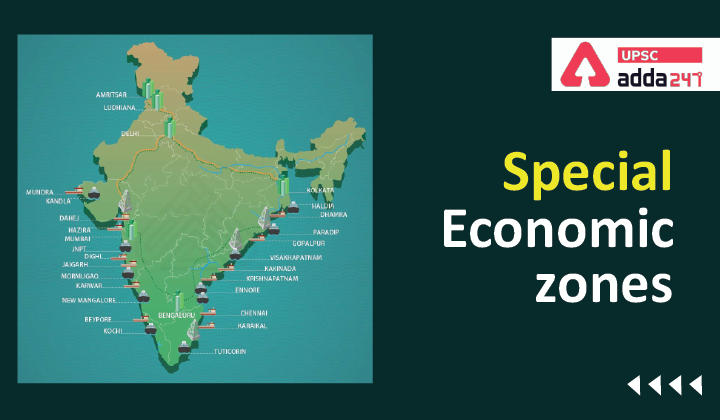Table of Contents
Special Economic Zones in India: Relevance
- GS 3: Indian Economy and issues relating to planning, mobilization, of resources, growth, development, and employment.
Special Economic Zones in India: Context
- In the recently presented budget for 2022, the government has said that the old SEZ (Special Economic Zones) Act will be replaced with new legislation for the development of enterprises and hubs.
Special Economic Zones in India: Key points
- The finance minister said that the new Act will cover the existing industrial enclaves and enhance export competitiveness.
- The reforms in customs administration are expected to support both the SEZs as well as other manufacturers in the domestic tariff area.
- Reforming the 16-year-old SEZ (Special Economic Zone) Act will boost exports, enhance competitiveness and remove anomalies in a sector that has been overlooked since the withdrawal of direct tax benefits.
What is SEZ?
- SEZ is a specially delineated duty-free enclave, which is deemed to be a foreign territory for the purpose of trade operations and duties and tariffs.
- SEZ can also be referred to as a geographical region that has economic laws different from a country’s domestic laws.
- One of the major objectives is to increase foreign investments.
- SEZs have been established in many countries including China, India, Jordan, Poland, and Russia.
Special Economic Zones in India
- India was one of the first in Asia to recognize the effectiveness of the Export Processing Zone (EPZ) model in promoting exports, with Asia’s first EPZ set up in Kandla in 1965.
- With a view to overcome the shortcomings experienced on account of the multiplicity of controls and clearances; absence of world-class infrastructure, and an unstable fiscal regime and with a view to attract larger foreign investments in India, the Special Economic Zones (SEZs) Policy was announced in April 2000.
- In order to streamline the SEZ establishment procedure, the government brought SEZ Act, of 2005.
- The Act provides the umbrella framework, covering all important legal and regulatory aspects of SEZ development as well as for units operating in SEZs.
Special Economic Zones Act, 2005
- The Special Economic Zones Act, 2005, was passed by Parliament in May 2005.
- The Act was aimed at providing drastic simplification of procedures and for single window clearance on matters relating to central as well as state governments.
The main objectives of the SEZ Act are
- generation of additional economic activity
- promotion of exports of goods and services
- promotion of investment from domestic and foreign sources
- creation of employment opportunities
- development of infrastructure facilities
The Special Economic Zones rules provide for
- Simplified procedures for the development, operation, and maintenance of the Special Economic Zones and for setting up units and conducting business in SEZs;
- Single window clearance for setting up of an SEZ;
- Single window clearance for setting up a unit in a Special Economic Zone;
- Single Window clearance on matters relating to Central as well as State Governments;
- Simplified compliance procedures and documentation with an emphasis on self-certification
Special Economic Zones committee
- Baba Kalyani headed an expert committee to review the SEZ policy and submitted its report in November 2018.
- It recommended significant changes in the SEZ policy.
- It included the formulation of separate rules and procedures for manufacturing and service SEZs.
SEZ located in India
- There were 7 Central Government Special Economic Zones (SEZs) and 12 State/Private Sector SEZs prior to the enactment of the SEZs Act, 2005.
- In addition, 425 proposals for setting up of SEZs in the country have been accorded formal approval under the SEZ Act, 2005.
- Presently, 378 SEZs are notified, out of which 265 are operational.
List of Special Economic Zones in India
Central government SEZs set up prior to the enactment of SEZ Act, 2005
| Sl. No. | Name of SEZ | Location |
| 1. | Kandla Special Economic Zone | Kandla, Gujarat |
| 2. | SEEPZ Special Economic Zone | Mumbai, Maharashtra |
| 3. | Noida Special Economic Zone | Uttar Pradesh |
| 4. | MEPZ Special Economic Zone | Chennai, Tamil Nadu |
| 5. | Cochin Special Economic Zone | Cochin, Kerala |
| 6. | Falta Special Economic Zone | Falta, West Bengal |
| 7. | Visakhapatnam SEZ | Vishakhapatnam, Andhra Pradesh |



 TSPSC Group 1 Question Paper 2024, Downl...
TSPSC Group 1 Question Paper 2024, Downl...
 TSPSC Group 1 Answer key 2024 Out, Downl...
TSPSC Group 1 Answer key 2024 Out, Downl...
 UPSC Prelims 2024 Question Paper, Downlo...
UPSC Prelims 2024 Question Paper, Downlo...




